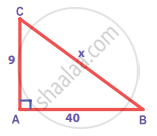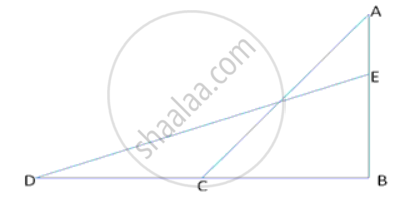Advertisements
Advertisements
प्रश्न
Find the unknown side in the following triangles
उत्तर
From ∆ABC, by Pythagoras theorem
BC2 = AB2 + AC2
Take AB2 + AC2
= 92 + 402
= 81 + 1600
= 1681
BC2 = AB2 + AC2
= 1681
= 412
BC2 = 412
⇒ BC = 41
∴ x = 41
APPEARS IN
संबंधित प्रश्न
The perpendicular AD on the base BC of a ∆ABC intersects BC at D so that DB = 3 CD. Prove that `2"AB"^2 = 2"AC"^2 + "BC"^2`
Sides of triangle are given below. Determine it is a right triangle or not? In case of a right triangle, write the length of its hypotenuse. 13 cm, 12 cm, 5 cm
Find the length of the perpendicular of a triangle whose base is 5cm and the hypotenuse is 13cm. Also, find its area.
The foot of a ladder is 6m away from a wall and its top reaches a window 8m above the ground. If the ladder is shifted in such a way that its foot is 8m away from the wall to what height does its tip reach?
The length of the diagonals of rhombus are 24cm and 10cm. Find each side of the rhombus.
In the given figure, PQ = `"RS"/(3)` = 8cm, 3ST = 4QT = 48cm.
SHow that ∠RTP = 90°.
In a right-angled triangle ABC,ABC = 90°, AC = 10 cm, BC = 6 cm and BC produced to D such CD = 9 cm. Find the length of AD.
An isosceles triangle has equal sides each 13 cm and a base 24 cm in length. Find its height
If S is a point on side PQ of a ΔPQR such that PS = QS = RS, then ______.
In an isosceles triangle PQR, the length of equal sides PQ and PR is 13 cm and base QR is 10 cm. Find the length of perpendicular bisector drawn from vertex P to side QR.
